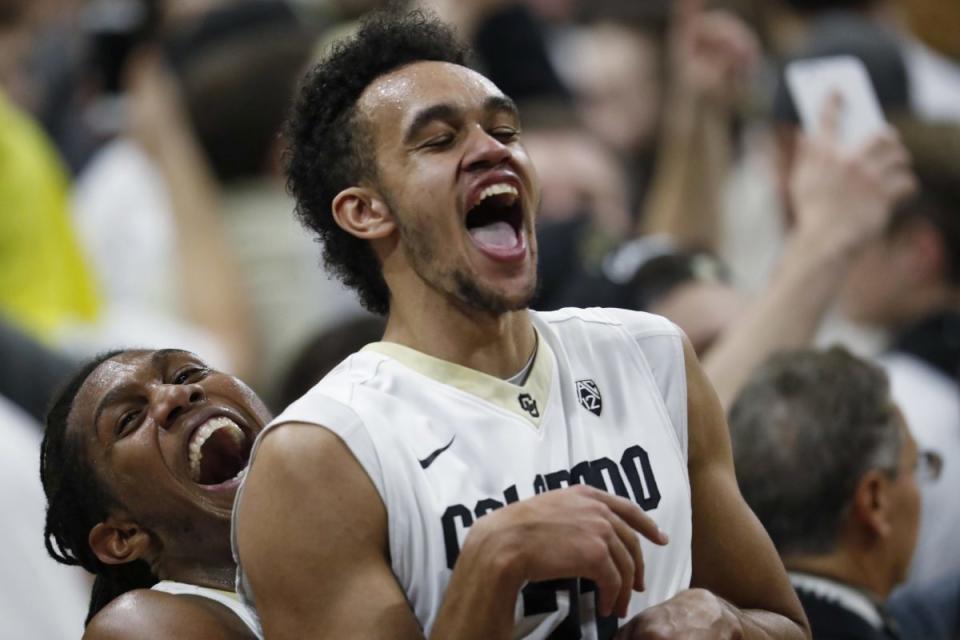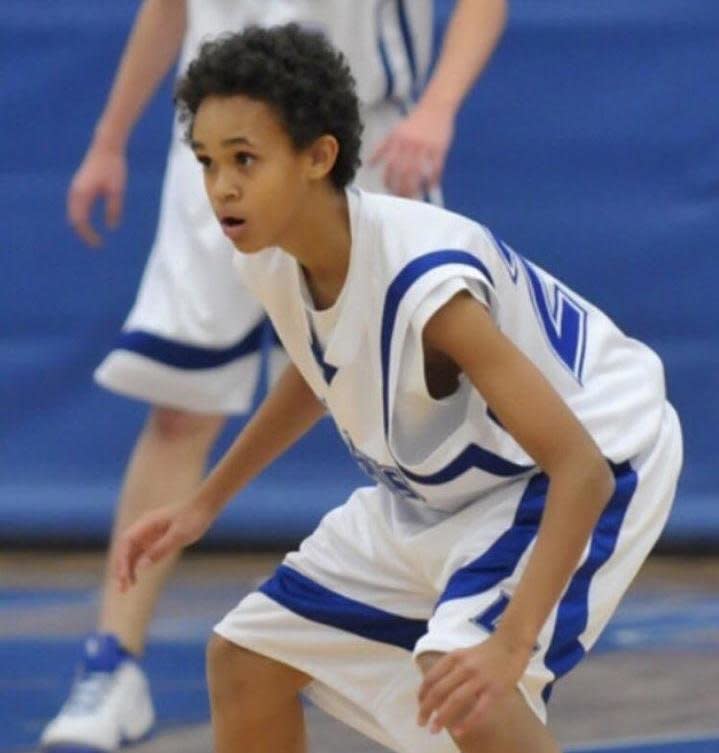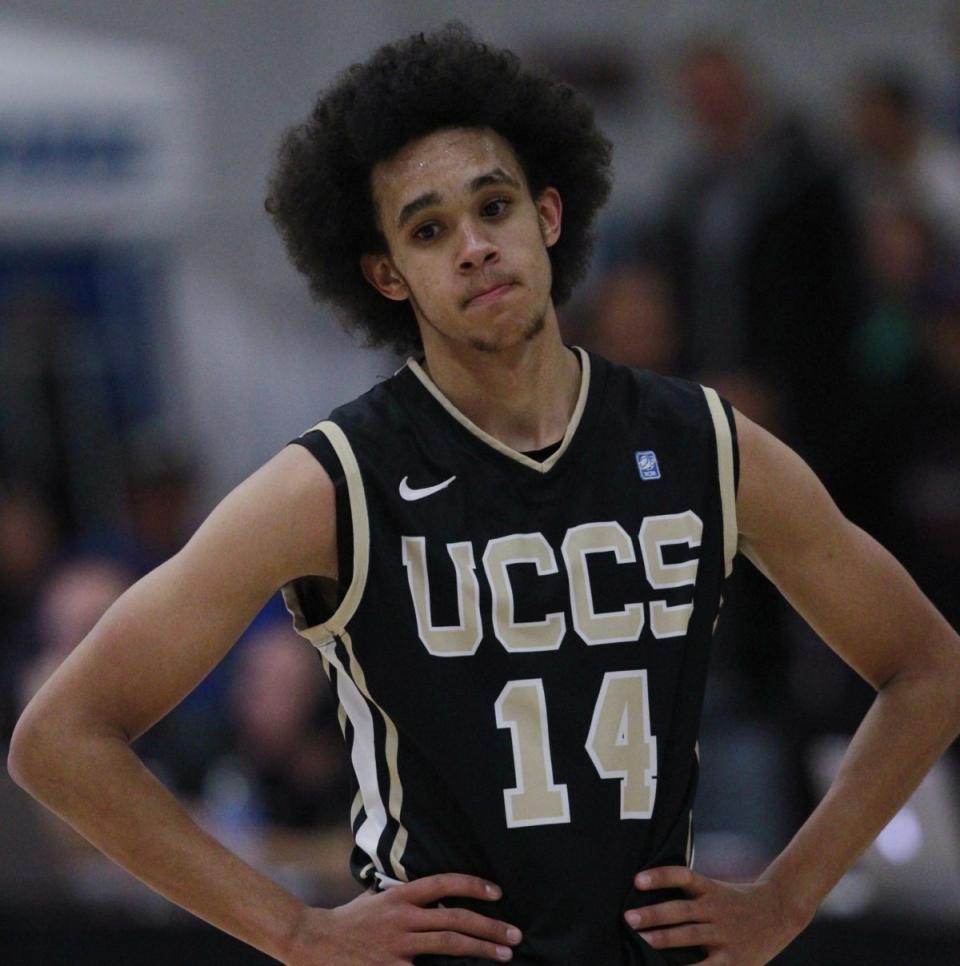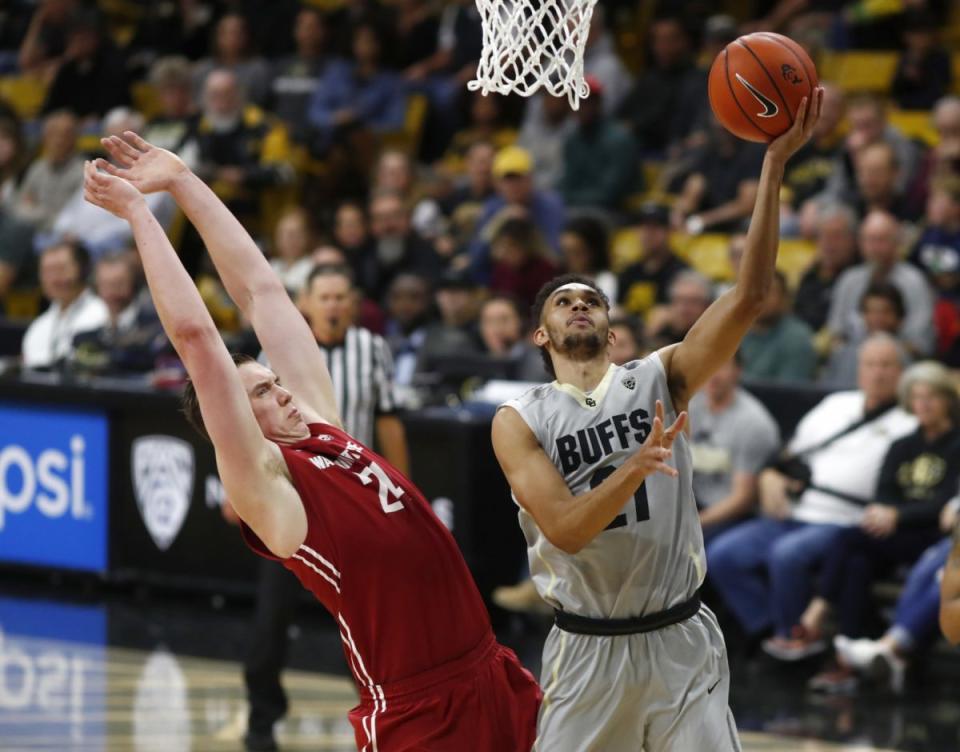How Colorado's Derrick White went from unrecruited to unlikely NBA prospect

Two months before he graduated from high school, Derrick White had all but abandoned hope of ever playing high-level college basketball.
He hadn’t received a single scholarship offer from a four-year university despite averaging nearly 20 points per game as a senior and leading his team to the round of 16 in Colorado’s toughest playoff division.
Desperate to help his son find somewhere to play in college, Richard White combed through dozens of Division II and NAIA rosters on the Internet in search of programs set to graduate their best guards. Richard then mailed his son’s bio and highlight package to 25 far-flung programs, from New Mexico Highlands, to Missouri Western, to Concordia University (Nebraska).
Most of the coaches who received Richard’s DVD didn’t bother to respond. The few who did politely told him they weren’t interested in a skilled yet scrawny 6-foot, 155-pound combo guard.
“No matter how many coaches we talked to or how many tapes we sent out, it always came back that he was too small to be a Division I or Division II-type player,” Richard White said. “We heard the same thing over and over.”
The only coach who showed sustained interest in White worked at a non-scholarship NAIA school best known for its renowned culinary arts program. Jeff Culver, head coach of Denver-based Johnson & Wales, scouted White throughout his senior season, invited him to participate in an open gym on campus and came away intrigued enough to offer him a spot on the team the following school year.
While White wasn’t sure about attending a school that produced more accomplished chefs than basketball stars, his other options weren’t any more enticing. He could have enrolled at one of several in-state Division II schools and asked for a tryout as a walk-on. Or he could have accepted an offer to play for a Wyoming junior college nearly 400 miles from home.
Just as White was poised to make his decision in April 2012, Culver landed the head coaching job at Division II University of Colorado Colorado Springs. Days later, he called White to offer a $3,000 per-year housing voucher and a spot on the team at UCCS.
At the time, it merely seemed like the long-awaited break White needed to secure a foothold in college basketball. There was no way of knowing it would also turn out to be the start of White’s dizzying ascent from fringe Division II prospect to the cusp of reaching the NBA.
* * * * *
Put a current picture of White next to one from when he was in high school, and it’s difficult to tell it’s the same person. In the past five years, he has undergone a stunning transformation, rocketing up to 6-foot-5, packing muscle onto his slight frame and adding explosiveness and bounce that he once lacked.
Fueled by the painful memory of being unwanted during high school, White has worked hard to take advantage of those newfound physical gifts. He became a Division II All-American after three years at UCCS, he earned first-team all-Pac-12 recognition last season after transferring to Colorado and he performed so well at last month’s Portsmouth Invitational Tournament that he landed an invitation to participate in this week’s NBA draft combine.
The kid who didn’t dunk in a game until his February of his senior year of high school now has enough bounce to make SportsCenter’s Top 10. The kid who didn’t receive one scholarship offer from a four-year college now attracts NBA scouts in droves. The kid whose first college game was witnessed by 128 people may soon be playing in front of 18,000 fans a night.
“There was absolutely no way to see this coming,” Colorado assistant Mike Rohn said. “You’re talking about a 6-foot skinny guy that nobody thought could even play college basketball. The growth spurt was a big part of it, but they don’t just hand you these opportunities because you’re a tall guard either. You’ve got to have the talent and you’ve got to work at your skills.”

Of the 67 prospects who will attend the draft combine in Chicago, White has taken easily the most improbable path. He’s one of only 15 players who weren’t originally Rivals 150 prospects, one of only three who didn’t sign with Division I programs out of high school and the only one who will use part of his first NBA contract to pay off student loans he accumulated paying for tuition at UCCS as a freshman.
Most NBA scouts project White as a second-round pick in the draft because he is a solid all-around combo guard who excels at scoring on the bounce, drawing fouls while attacking the rim or creating for his teammates off the dribble. He has a chance to solidify himself as a second-round sleeper or perhaps even improve his stock further if he showcases a consistent jump shot and sustained defensive intensity during the combine and subsequent individual workouts.
“I’ve heard late first round, I’ve heard second round, I’ve heard undrafted, I’ve heard a lot of things,” White said. “But I’m trying not to focus too much on that. I’m trying to focus on getting better each day and playing well when I have the opportunity to show what I can do in front of NBA teams. If I do that, the rest will take care of itself.”
* * * * *
Ask college coaches in Colorado why they passed on a future NBA prospect five years ago, and they typically offer one of two reasons White went overlooked.
Some didn’t know about him because he played with his high school teammates on the AAU circuit instead of joining a more visible club program.
“I had never even heard of the kid,” former Colorado State coach Tim Miles confessed.
Others saw him play yet remained unconvinced he possessed the size, strength or speed necessary to thrive in Division I or Division II basketball.
“He’s not the same kid physically at all now that he was five years ago,” former Denver coach Joe Scott said.
When White enrolled at Legend High School as a baby-faced freshman, he stood only 5-foot-7 and was slender as a sapling. A bushy afro couldn’t disguise that he had only sprouted to a shade over 6 foot by the time he graduated four years later.
In a state that typically isn’t teeming with coveted basketball prospects, White’s modest physical stature didn’t prevent him from scoring more than 1,000 points in his high school career and blossoming into an honorable mention all-state selection as a senior. He impacted the game in numerous ways, curling around screens for catch-and-shoot 3-pointers, creating for himself or his teammates off the bounce or using his long arms and keen instincts to deflect passes and create turnovers.
The consensus among college coaches at the time was that White’s game wouldn’t translate at a higher level. They feared he lacked the size and quickness to defend opposing guards, the burst to blow by bigger, more athletic defenders or the strength and body control to finish through contact at the rim.
“I called about 50-60 coaches about him, but Derrick just didn’t pass the eye test at that point,” said Marcus Mason, White’s longtime trainer and mentor. “He looked like a ninth grader his senior year of high school. He was about 5-11 without the hair and very, very skinny.”
Hearing he wasn’t good enough over and over was very frustrating for White.
Cory Calvert and Josh Adams, two of White’s close friends and training partners from his neighborhood in the Denver suburbs, both received invitations to play for the state’s top AAU teams and scholarship offers from some of the region’s best Division I programs. When Calvert signed with BYU and Adams chose Wyoming, White felt like he was being left behind.
“Derrick was probably the best player of the group at the time, but Cory and Josh were getting all the pub and they both ended up at Division I schools,” Legend High School coach Kevin Boley said. “I have no doubt that was hard for Derrick, but Derrick is such a good kid and such a genuinely gracious kid. I think he just used that to motivate himself to work harder.”
* * * * *
The only college coach who vigorously pursued White admits even he had no inkling he was recruiting a future NBA prospect.
Culver merely envisioned White emerging as a potential starter at UCCS in the latter half of his college career once he got bigger and stronger.
He knew White would still be only 17 years old when he graduated high school. He knew White’s father had a late growth spurt during college. Doctors had also studied White’s growth plates the previous year and projected he might one day stand as tall as 6-foot-5.
“I didn’t think I grabbed a future pro or a D-I kid that slipped through the cracks, but I felt like he was at least going to be able to progress into a very good Division II player,” Culver said. “We look for young seniors when we can and Derrick’s hand size, foot size and wingspan were all very intriguing coming out of high school. I started asking more questions, finding out about his work ethic and his character. All his coaches spoke so highly of him, yet the recruiting wasn’t there.”

From the end of his senior season at Legend High to the start of his freshman season at UCCS, White shot up about four inches taller and his slight frame began to fill out. Suddenly, the spindly kid who Culver envisioned redshirting as a freshman evolved into one of the team’s most indispensable guards in practice.
Eager to give White a full year to bulk up in the weight room, Culver initially stuck to his plan to redshirt his top freshman. Only after one of his senior guards suffered an injury during an exhibition game did Culver change his mind and immediately elevate White from the scout team to the starting lineup.
“I was playing really well in practice and making things happen, so coach decided to give me a chance,” White said. “It was a crazy jump from thinking I wasn’t going to play that season, but it gave me a lot of confidence. I wanted to prove people wrong that didn’t recruit me, and this was my chance.”
It didn’t take long for the rest of the coaches in the Rocky Mountain Athletic Conference to learn they had made a mistake passing on White.
He earned the league’s freshman of the year award in 2013 after averaging 16.9 points per game on a 21-loss team. He increased his average to 22.2 points per game the following year while becoming a more efficient scorer and taking better care of the ball. He became an all-around force as a junior while leading UCCS to the Division II NCAA tournament, tallying 25.8 points per game, shattering his own program record for free throws attempted and averaging 7.4 rebounds, 5.2 assists and 2.1 blocks.
By the time he torched Colorado School of Mines for 50 points, 14 rebounds, 8 assists and 3 blocks in the second-to-last game of his junior season, White had established himself as one of Division II’s premier talents. The only remaining question was whether he’d find similar success against stronger competition.

* * * * *
At the end of his junior season, White met with his parents and Mason to discuss his options for his final year of college basketball.
One was to remain at UCCS, build on the previous year’s dominance and try to become the first Division II player selected in the NBA draft since Shaw University’s Ronald Murray in 2002. The other was to seek his release, transfer to a more prominent program and embrace the challenge of proving himself at the Division I level.
NBA scouts had already begun requesting credentials for UCCS games and calling Culver for background information, but White knew there would be skepticism about whether he could make the leap all the way from Division II to professional basketball. Transferring to a prominent Division I program was White’s one chance to eliminate such concerns, but it would also mean deserting the coaching staff that gave him his big break.
“It was a difficult decision, but eventually Derrick decided he was ready for a new challenge,” Mason said. “He understood he wasn’t going to get a fair shake as an NBA prospect from a Division II school. He felt like if he was going to get a fair shake he needed to push himself at another level.”
Having to ask Culver for his release was agonizing for White, but Division I scholarship offers poured in soon afterward. Among the first to reach out was Colorado, which had been tracking his progress from afar the previous year.
When White would meet Josh Scott, Wesley Gordon and Xavier Talton in Denver to play in offseason pickup games, the Colorado players would return to Boulder raving about how much their friend had improved since high school. Scott told Rohn that White would be the Buffaloes’ best player since 2011 NBA lottery pick Alec Burks if they landed him.
“The Division II coaches that we knew, they would be like, ‘Holy cow, this guy is really, really good,'” Rohn said. “We looked at his stats, watched film and it was pretty much a no brainer. If he wanted to come, we were going to take him.”
Not long after White chose Colorado over Boise State, UTEP and Utah State among others, the Buffaloes staff got a preview of how big an impact their newest recruit would have. White regularly kept the scout team competitive with the starting five during practice, scoring at all three levels, consistently drawing double teams and typically making the proper pass to beat them.
Taking advantage of his newfound access to a nutritionist and strength coach at Colorado, White further revamped his body during his redshirt year, lifting weights five days a week to add muscle to his long, lean frame. Extra shooting work helped him become a more consistent shooter from behind the arc and facing better competition during practice forced him to learn not to take plays off defensively as often.
The results were unmistakable as White averaged 18.1 points, 4.4 assists and 4.1 rebounds during his lone season at Colorado. In a league that featured potential No. 1 draft picks Markelle Fultz and Lonzo Ball as well as fellow perimeter standouts Dillon Brooks, Allonzo Trier and Tyler Dorsey, White was as productive as any of them.
* * * * *
The knock on most fifth-year seniors in that they’re finished products, that they don’t have the upside or room for growth that NBA teams crave on draft day.
The way those close to White see it, that shouldn’t apply to a late bloomer like him as much.
He’s still only 22 years old. He still has room on his frame to get stronger. He also has played only one season of Division I ball and could benefit from being challenged more consistently.
“We tried our best to push him, but the reality is for three years he was hands-down the best player on our team and in our conference,” Culver said. “The hope was that he’d go to Colorado and go against all this top competition every day, but he ended up the best player on that team too. I’m not saying they didn’t push him, but I do feel like when he gets onto a team where he’s not the best player, he’ll be able to make some adjustments and grow his game even further.”
If White hears his name called on draft day, it will be an unfathomable yet emotional moment for friends and family who have shared this journey with him.
They’ve seen him work tirelessly to overcome his size limitations and earn an opportunity to play in college. They’ve seen him make it look easy leaping from Division II to a Pac-12 program. Now they have no doubt White will defy the odds once more and carve out a niche in the NBA.
“That would probably be our happiest moment,” Richard White said. “He’s put a lot of sweat equity into getting this accomplished. He’s got his opportunity. Now it’s what he makes of it.”
– – – – – – –
Jeff Eisenberg is the editor of The Dagger on Yahoo Sports. Have a tip? Email him at daggerblog@yahoo.com or follow him on Twitter!
More from Yahoo Sports:
• Dan Wetzel: Aaron Hernandez’s murder conviction vacated
• Former Celtics explain beef with Ray Allen
• Sidney Crosby and the NHL’s playoff concussion disaster
• Warriors finish off Jazz, match Cavs’ playoff perfection
• Tony Romo fails to advance in U.S. Open qualifier


